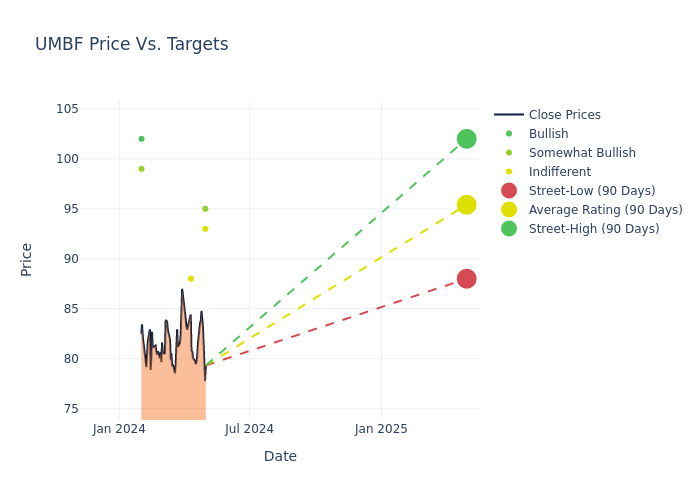6 analysts have shared their evaluations of UMB Financial (NASDAQ:UMBF) during the recent three months, expressing a mix of bullish and bearish perspectives.
The table below provides a snapshot of their recent ratings, showcasing how sentiments have evolved over the past 30 days and comparing them to the preceding months.
| Bullish | Somewhat Bullish | Indifferent | Somewhat Bearish | Bearish | |
|---|---|---|---|---|---|
| Total Ratings | 1 | 2 | 3 | 0 | 0 |
| Last 30D | 0 | 1 | 1 | 0 | 0 |
| 1M Ago | 0 | 0 | 1 | 0 | 0 |
| 2M Ago | 0 | 0 | 1 | 0 | 0 |
| 3M Ago | 1 | 1 | 0 | 0 | 0 |
Analysts have recently evaluated UMB Financial and provided 12-month price targets. The average target is $94.67, accompanied by a high estimate of $102.00 and a low estimate of $88.00. Marking an increase of 10.21%, the current average surpasses the previous average price target of $85.90.

Interpreting Analyst Ratings: A Closer Look
The perception of UMB Financial by financial experts is analyzed through recent analyst actions. The following summary presents key analysts, their recent evaluations, and adjustments to ratings and price targets.
| Analyst | Analyst Firm | Action Taken | Rating | Current Price Target | Prior Price Target |
|---|---|---|---|---|---|
| Jared Shaw | Barclays | Raises | Overweight | $95.00 | $91.00 |
| Christopher Mcgratty | Keefe, Bruyette & Woods | Raises | Market Perform | $93.00 | $86.00 |
| Timur Braziler | Wells Fargo | Raises | Equal-Weight | $88.00 | $85.00 |
| Jared Shaw | Barclays | Announces | Equal-Weight | $91.00 | - |
| Nathan Race | Piper Sandler | Raises | Overweight | $99.00 | $87.50 |
| David Long | Raymond James | Raises | Strong Buy | $102.00 | $80.00 |
Key Insights:
- Action Taken: In response to dynamic market conditions and company performance, analysts update their recommendations. Whether they 'Maintain', 'Raise', or 'Lower' their stance, it signifies their reaction to recent developments related to UMB Financial. This insight gives a snapshot of analysts' perspectives on the current state of the company.
- Rating: Analyzing trends, analysts offer qualitative evaluations, ranging from 'Outperform' to 'Underperform'. These ratings convey expectations for the relative performance of UMB Financial compared to the broader market.
- Price Targets: Analysts predict movements in price targets, offering estimates for UMB Financial's future value. Examining the current and prior targets offers insights into analysts' evolving expectations.
To gain a panoramic view of UMB Financial's market performance, explore these analyst evaluations alongside essential financial indicators. Stay informed and make judicious decisions using our Ratings Table.
Stay up to date on UMB Financial analyst ratings.
Delving into UMB Financial's Background
UMB Financial Corp, or UMBF, is a financial services holding company offering a suite of banking, asset management, and health spending solutions. Its customer base includes commercial, institutional, and personal customers across the United States. The company's banking subsidiaries own and operate banking and wealth-management centers mostly throughout the Midwest and Southwest regions of the U.S. Subsidiaries of the holding company and its lead bank, UMB Bank, include mutual fund and alternative investment services groups, single-purpose companies that deal with brokerage services and insurance, and a registered investment advisory. The bank's revenue is split nearly evenly between interest income and noninterest income.
Understanding the Numbers: UMB Financial's Finances
Market Capitalization Perspectives: The company's market capitalization falls below industry averages, signaling a relatively smaller size compared to peers. This positioning may be influenced by factors such as perceived growth potential or operational scale.
Revenue Growth: UMB Financial's revenue growth over a period of 3 months has faced challenges. As of 31 December, 2023, the company experienced a revenue decline of approximately -1.45%. This indicates a decrease in the company's top-line earnings. As compared to its peers, the revenue growth lags behind its industry peers. The company achieved a growth rate lower than the average among peers in Financials sector.
Net Margin: UMB Financial's net margin is below industry averages, indicating potential challenges in maintaining strong profitability. With a net margin of 21.18%, the company may face hurdles in effective cost management.
Return on Equity (ROE): UMB Financial's ROE is below industry averages, indicating potential challenges in efficiently utilizing equity capital. With an ROE of 2.4%, the company may face hurdles in achieving optimal financial returns.
Return on Assets (ROA): UMB Financial's ROA falls below industry averages, indicating challenges in efficiently utilizing assets. With an ROA of 0.17%, the company may face hurdles in generating optimal returns from its assets.
Debt Management: The company maintains a balanced debt approach with a debt-to-equity ratio below industry norms, standing at 0.45.
Analyst Ratings: What Are They?
Benzinga tracks 150 analyst firms and reports on their stock expectations. Analysts typically arrive at their conclusions by predicting how much money a company will make in the future, usually the upcoming five years, and how risky or predictable that company's revenue streams are.
Analysts attend company conference calls and meetings, research company financial statements, and communicate with insiders to publish their ratings on stocks. Analysts typically rate each stock once per quarter or whenever the company has a major update.
In addition to their assessments, some analysts extend their insights by offering predictions for key metrics such as earnings, revenue, and growth estimates. This supplementary information provides further guidance for traders. It is crucial to recognize that, despite their specialization, analysts are human and can only provide forecasts based on their beliefs.
This article was generated by Benzinga's automated content engine and reviewed by an editor.
